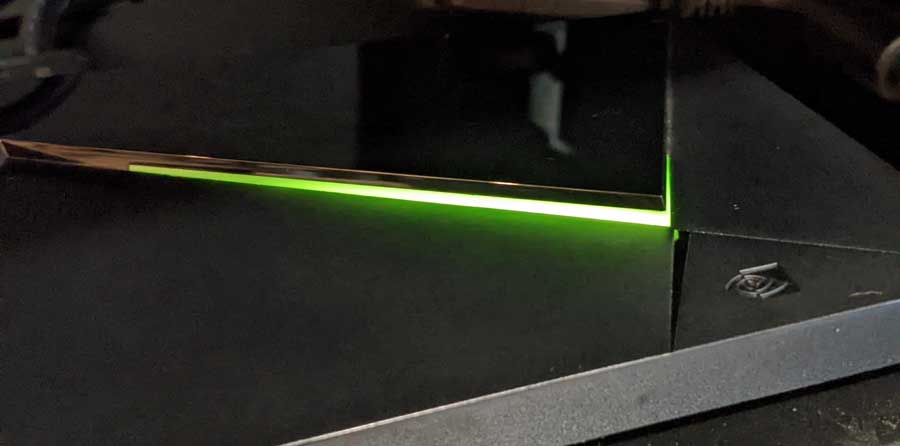Last Updated on July 3, 2023 by Tim Wells
As good as it is, the NVIDIA Shield still runs into issues, usually centered on display issues where it won’t turn on.
This article covers a troubleshooting checklist of steps to take when encountering this issue. We’ll also cover when you see the green light on your Shield TV (signaling it’s on) but your TV screen is black.
You’ll want to pack your patience and put your troubleshooting hat on.
Let’s fix your NVIDIA Shield not turning on.
NVIDIA Shield Not Turning On? Check the Power Cable First
You’d be surprised how often the issue comes down to something simple. So we’re going to look at two easy solutions first.
Start by checking the power cord from your NVIDIA Shield to where it’s plugged in for power.
Of course, if your Shield is not plugged in, it won’t turn on.
Assuming that’s not the issue, let’s test whether your power cable is functioning.
Unplug your NVIDIA Shield power cord from the outlet and plug in something else in the same spot.
The goal is to test whether the issue is your Shield TV power supply or the power outlet.
To make things simple, grab the closest table lamp. If the light turns on, you may have a faulty power cable.
The NVIDIA Shield uses a proprietary power cord, so you won’t be able to buy a replacement from your local Best Buy. You’ll have to order one directly from NVIDIA.
Unfortunately, several users on NVIDIA’s official forum have reported challenges because NVIDIA doesn’t sell the cables directly.
Amazon does sell several different replacements. However, it’s important to do your research here.
Since it’s a proprietary cable, you may end up with a lesser-quality replacement or one that doesn’t fit the Shield’s power input.

Check the HDMI Port & Input on Your TV
Next, ensure your TV is set to the correct HDMI input. You may need to pull your TV away from the wall to get a better view.
Follow the HDMI cable from your NVIDIA Shield to your TV and note which HDMI port it’s connected to your TV.
Next, grab your TV’s remote control and verify that the Shield and TV are set to the same input.
For example, if your Shield TV is plugged into HDMI-1, the input should also be set to HDMI-1.
Once you’re sure that you’re on the correct port, it’s time to check the HDMI cable.
Try a different HDMI cable to see if that’s the problem. Often, HDMI cables can fail due to age or damage, so trying a different cable could solve the issue.
Restart (Power Cycle) Your NVIDIA Shield TV
If you’re sure your NVIDIA Shield is getting power, check the LED power indicator to be illuminated green.
Unless you purposefully disabled it in the Shield TV Settings menu, it will light up when the Shield is powered on.
If the LED is not lit up, then there’s no power.

However, if the indicator light is lit up and there’s no picture on your TV, you may need to restart the device.
While there’s no obvious power button on the NVIDIA Shield, most Shield TV and the Shield TV Pro versions have a virtual power button similar to Samsung TVs.
Run your hand along the green light, which will power on the device.
Unfortunately, the 2019 Shield TV “Tube” doesn’t have a physical power switch.
You can physically unplug the Shield TV from the wall in either case. Once you do, please wait 10 seconds before plugging it back in or pressing the power button.
Check for Issues with the Remote/Controller
The remote/controller could be another reason why your NVIDIA Shield not turn on.
Start by inspecting the batteries. Go to Settings > Remotes & Accessories > SHIELD Accessories.
Select your remote.
If the battery level is low or critical, replace them with fresh batteries.
You can also check to see if your remote and Shield TV are no longer paired on this screen. If your device doesn’t appear on the list, unpair and re-pair it.
Test another remote/controller. Use a universal remote, game controller, or a wireless mouse or keyboard. You can also control your device using the Shield TV app on your phone.
If your remote/controller is faulty, try resetting it. Hold the back and home buttons for 15 seconds until the LED light flashes. This clears the pairing information.
Does the remote/controller need an update?
Check this under Settings > Remotes & Accessories > SHIELD Accessories. Select your device. An update option appears if one is available. Connect your device to the internet and ensure it has enough battery before updating.
Contact customer support if the remote/controller is still unresponsive. Visit Nvidia’s official website. Chat online, submit a ticket, or call their toll-free number.
Common remote/controller issues include:
- A non-functioning LED light.
- The inability to power on the device.
- A lack of command responsiveness.
These issues could suggest various problems, including a low battery, pairing or power issue, firmware issue, Bluetooth interference, or a cache issue.
How do you fix these issues?
Replace the batteries if the LED light doesn’t light up. If the remote/controller doesn’t turn on the device, use the device’s power button or try an alternate remote/controller. Unpair and re-pair the device.
Does the remote/controller not respond or perform slowly?
Update the firmware for the remote/controller and the device.
Clear the device cache under Settings > Apps > See All Apps > Show System Apps > Bluetooth > Storage & Cache > Clear Cache. Also, consider swapping HDMI cables or avoiding USB cables, hubs, and drives that might cause interference.
Factory Reset your NVIDIA Shield
Sometimes your Shield will get to a point where the only thing that works is a factory reset.
Factory resetting your Shield TV will cause you to lose all your saved settings. However, at least you’ll start from a point where you know the device works properly.
I have a dedicated article covering resetting your NVIDIA Shield to factory specs. However, I’ll briefly outline the steps here as well.
If you can reach the home screen, click on the Settings menu in the upper right-hand corner.
Click on Device Preferences, and then press Reset. Select the Reset button.
But you’ll be prompted again and made to understand that a Factory Reset will clear all saved settings from this device. It’s simple stuff. If you’re sure of the decision you’re making – then click the Erase everything button.
Once you’ve done that, your Shield will clear all the data and go with a fresh install of its operating system.
This process may take a few minutes, so be patient. Once complete, you’ll need to make sure your software updates. Then get the Shield set up the way you had it before.
Software and Firmware Update
Unfortunately, this won’t work if you can’t reach the home screen. However, updating your Shield TV may fix it if it won’t turn on intermittently in the future.
NVIDIA bundles its software and firmware updates in the NVIDIA Shield Experience package. Each new version contains bug fixes and new features, updating the code to help it run more efficiently.
The Shield TV is set to automatically download and update itself by default. However, you will get a notification when it has been updated.
But, if you want to check to see if your software is up-to-date, head to the Settings menu. From there, click on About, followed by System Updates.
In that menu, your Shield will check to see if any software updates are available. If there are, you can start the download and install them immediately or overnight during the off hours.
If you don’t have your Shield TV set to update automatically, you should check every few weeks to see if there’s a patch available that you may have missed.
Repair or Replace Your NVIDIA Shield
Do you feel like you have exhausted every possible option for troubleshooting your Shield? The next step would be sending it in for repair or simply replacing the unit.
First, look at when you purchased your NVIDIA Shield to see if it’s still under warranty.
According to NVIDIA, their Shield line of products comes with a one-year warranty from the date of sale. That warranty covers damage “under normal use conditions for manufacturing defects or hardware component failures in your Warranted Product that is still within warranty.”
Essentially, NVIDIA will cover damage that isn’t caused by you dropping it down a flight of stairs or throwing it off a tall building.
That warranty would drop to 3 months if you purchased your Shield as a refurbished product.
So, if your Shield is on the fritz for reasons outside your control, contact NVIDIA’s Customer Care Department.
You will work with an NVIDIA representative who will likely go through the same troubleshooting steps you’ve tried, then develop a plan for repair or replacement.
NVIDIA will likely send you a new Shield. Especially if your Shield is not working due to a hardware defect or a software update bricked the unit.
Remember, it is always good advice to hold on to your receipt or e-mail that contains the proof of purchase and your purchase date. If you are replacing your Shield due to a defect, you must prove that the device remains under warranty.
Wrapping It Up
The NVIDIA Shield, a powerful and popular Android TV device for streaming and gaming, can sometimes hit a roadblock – it refuses to turn on. You’ve walked with us through a step-by-step guide designed to tackle this issue, and by now, you should have a better understanding of the potential causes and their respective solutions.
We’ve checked for the usual suspects, like faulty cables and potential power issues. We’ve ensured that your remote/controller isn’t the problem and verified that the correct HDMI input is on your TV. From a simple power cycle to a more drastic factory reset, you’ve learned how to troubleshoot common issues and apply solutions.
When the green LED light flickers on or the NVIDIA logo graces your screen, it signifies a successful power cycle. If the problem lay with your remote/controller, our guide on checking its functionality and addressing common issues would have been invaluable. For stubborn problems, a factory reset could be your silver bullet, though it comes with its own baggage of data loss.
A few quick clicks on your TV remote could resolve an HDMI input issue while meddling with CEC settings and changing HDMI ports serve as effective alternative solutions.
This guide was designed to be your companion during those frustrating moments when your NVIDIA Shield refuses to power up. Armed with this information, we trust that you’ll get back to your streaming and gaming in no time.
Remember, sometimes, the solution is simpler than it seems. So, before you panic, walk through these steps, and you’ll likely find your Nvidia Shield humming back to life.
- How to Install Kodi Diggz Xenon Plus & Free99 Build [March 2024] - March 3, 2024
- How to Enable Unknown Sources on Chromecast with Google TV [2024] - October 30, 2023
- How to Install the Seren Kodi Addon [2024] - October 29, 2023

